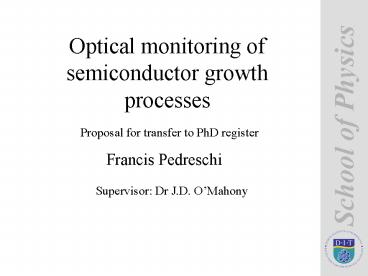Optical monitoring of semiconductor growth processes - PowerPoint PPT Presentation
1 / 21
Title:
Optical monitoring of semiconductor growth processes
Description:
Develop a system for monitoring the growth of semiconductors ... Directions are chosen so bulk reflectivity is largely negated. School of Physics. Examples ... – PowerPoint PPT presentation
Number of Views:43
Avg rating:3.0/5.0
Title: Optical monitoring of semiconductor growth processes
1
Optical monitoring of semiconductor growth
processes
Proposal for transfer to PhD register
- Francis Pedreschi
Supervisor Dr J.D. OMahony
2
Aims of Project
- Develop a system for monitoring the growth of
semiconductors - To use this system to examine certain test systems
3
Why?
- Growth of semiconductors must be monitored and
controlled. - Semiconductor device miniaturisation.
- Current methods may be destructive on small scale.
4
Current monitoring methods
- Electron beam techniques.
- Surface specific.
- High energy electrons.
- Cumbersome equipment.
- Difficult to get surface specificity with optical
probes
5
Reflectance Anisotropy Spectroscopy
- Measures reflectivity of polarised light along
two directions and reports the difference. - Directions are chosen so bulk reflectivity is
largely negated.
6
Examples
- Growth Oscillations, fixed energy
7
Examples
- Variable energy
8
Model systems for testing.
- Must mimic application conditions.
- Small structures.
- Interesting Physics
9
Results
10
Results
11
Results
- Largest published RAS response for a
metal-semiconductor system. - Indicates electron localisation.
- Demonstrates growth monitoring
12
Extension to PhD.
- Low dimensional systems.
- Unusual properties.
- Characterise using a variety of methods.
- Unfinished work on indium-silicon systems
13
Indium-Silicon
- RAS has already been performed on other indium
silicon systems. - These have not been extensively studied.
- RAS and photoemission.
14
Other Systems
- Ordered arrays of metal particles.
- Iron particles produced locally.
- Cobalt clusters produced by IBM.
15
Iron Particles
- Structure
- Films
Metal Particle
Polymer Coating
16
Cobalt Particles
- Particles difficult to produce
- Form well ordered films
17
Reasons for Study
- Properties of low dimensional systems.
- Magnetic properties-IBM.
- Magnetic storage media.
- Read/write heads.
- Complementary work.
18
Methods
- RAS?
- Ellipsometry
- Magneto Optical Kerr Effect
- Magnetic Circular X-Ray Dichroism
- Atomic Force Microscopy
- Magnetic Force Microscopy
19
Facilities.
- RAS in DIT and Liverpool
- Metal Particles in TU Eindhoven
- MCXD in Hamburg
20
Timeplan for project
- Work in Eindhoven completed by December 1999
- Work in IRCSS Liverpool performed early 2000
21
Summary
- RAS successfully demonstrated.
- Funding and facilities for project extension.
- Work of practical interest.
- Should be completed within 18 month time limit.































